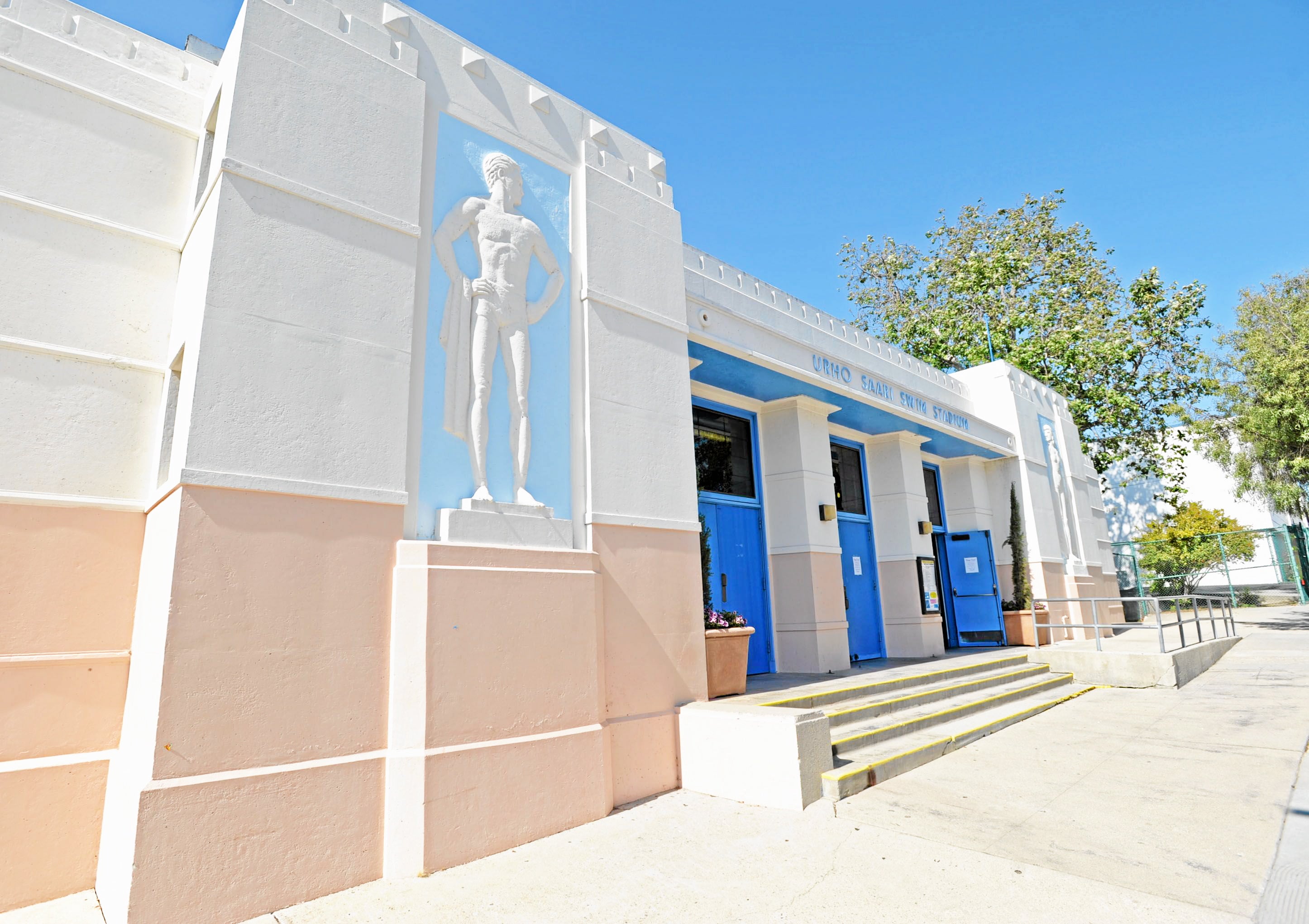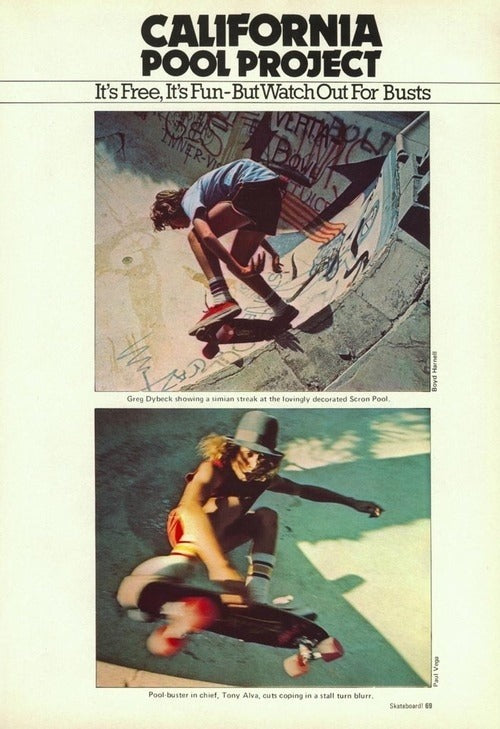
More than the palm trees or the Hollywood sign or any other man-made beacon heralding that home is within grasp, it’s the sight a mile-high out of an airplane window of those blue and green patches dotting the landscape, like so many puddles across the over-developed terrain, that signal a return, finally, to Los Angeles.
L.A. is beyond a shadow the promise land of the swimming pool. Angelenos didn’t invent them, of course. There were great baths carved out and tiled in Pakistan and Greece and Rome eons before virgins were inexplicably giving birth to saviors. Yet like so much re-imagined by the Tinseltown machine, the body politic (and what bodies they are thanks to a surfeit of camera-ready DNA) simply made the entire notion of swimming pools more fabulous. The image of the bronzed babe, clad in a swatch of fabric and dark sunglasses, stretched out against a cerulean pool has topped the California iconography and engaged the popular imagination worldwide for a century. It may not even have to be so obvious, simply hang there like the August air, as in the works, both photographic and painted text, of Ed Ruscha, an Oklahoma transplant who made L.A. home in 1957. A year later, a neglected pool would serve as the stylish setting for faded glory and vengeful murder in Sunset Boulevard.

Pools in California, conspicuously in sun-drenched, starry-eyed and sprawling Southern California, have always represented more than a healing tonic and fitness source. Be it a lavish lap pond or mass-made kidney bean or even the humble hot tub and sensually charged Jacuzzi, here they brim with as much chlorine as social life and status. In the Golden State, swimming pools, private or public, are like a driver’s license at age 16 and a credit listed on IMDB, birthrights among those bred here, an amniotic fluid that inexorably forms even those among us who may never get beyond a dog paddle.
The swimming pool is California’s symbolic fountain of youth.
You don’t even have to get wet to make a splash. Norma Shearer gave pool boys hope forever after when she “discovered” Robert Evans at the pink-soaked Beverly Hills Hotel, casting him as her late husband, MGM producer Irving Thalberg, in the 1957 film Man of a Thousand Faces. What gifts the ripened actress spotted in a nearly buff Evans didn’t quite translate on screen (though it would eventually behind the scenes). As the British thespian Cedric Hardwicke once sniffed: “…God felt sorry for actors, so he created Hollywood to give them a place in the sun and a swimming pool. The price they had to pay was to surrender their talent.”
As long as there have been stars in the hills (whatever hills were in vogue at the time across this sprawling city), there have been pools to swim in and sunbathe around.
The so-called “Versailles of Hollywood,” the 118-room beachfront compound built in 1929 for Marion Davies, silent screen star, party girl and paramour of media mogul Randolph Hearst, boasted a 110-foot pool of Venetian marble filled with saltwater. And this after architect Julia Morgan also created the opulent indoor and outdoor pools at the couple’s extravagant estate up north in San Simeon. The Santa Monica beach house had its run of three-day parties lasting until 4 a.m. during Marion’s heyday. Yet, as so many great homes in L.A., it was razed long ago. In 2009, after 10 years and millions of dollars, philanthropist Wallis Annenberg opened the site as the nation’s first and only public beach club, a no-membership-required playground complete with volleyball and tennis courts within steps of the Pacific Ocean. (Of course, like so many other public pools here and everywhere, it remains closed for now due to life-saving social distancing guidelines.)

Some 20 minutes south of the Annenberg Community Beach House is the suburb El Segundo where I spent my first years in white-picket splendor as a 1970s aerospace baby. Among my favorite childhood haunts was the Plunge with its the giant indoor pools. Officially it’s the Urho Saari Swim Stadium, built as a federal Work Projects Administration building in 1940 by John C. Austin, the architect behind the Shrine Auditorium, the L.A. City Hall and the Griffith Observatory. I loved the tall bas-relief sculptures at the entrance of a man and woman in their of-the-period maillots, and the cold marble floors inside the dressing areas. When the weather outdoors dropped during the gloom of June and our mothers thought the 68 degrees too cold to spend the day in the backyard pools, we’d seek cover there.
Such a pick of pools to spend idyll hours as a kid growing up here! Consider the lessons in geometry alone: oval, rectangle, diamond, L-shape. In 1935, Richard Neutra and Isamu Noguchi conceived of the first kidney-shaped pool for the Joseph von Sternberg home in L.A. It was never realized. In fact, the first one in that shape came about 13 years later in 1948 way up north in Sonoma. Go figure. 
Pools held another lure for a wild bunch growing up in Ocean Park, an enclave between Santa Monica and Venice most famously known as Dogtown. Overdevelopment prompted the inevitable abandonment of countless pools here and around the state’s many suburban neighborhoods, spurning a revolution in an already rogue sport, skateboarding. Among the pioneers were the Dogtown motley crew known as Z-Boys, with its scrappiest seditionary, Tony Alva.
Even into their 20s, these guys wouldn’t let up. My boyfriend during college, a career skateboarder would join other friends who, going from pauper to pro and collecting unimaginable earnings on their board royalties, would splurge on helicopter rides to scope out empty pools throughout Southern California. Sometimes it would involve a day of shoveling out the dredge of years, even patching up any pocks in the concrete, before returning a day or week later to enjoy the fruits of their unlawful hunt. As fortunes climbed for some, they would build their own backyard pools—which would never see a drop of chlorinated water. The Taj Mahal of such efforts is the 4,000-square-foot bowl, actually a skate park with a pyramid in the middle built in a residential backyard by another Tony, skateboarding superstar Tony Hawk, in a suburban enclave of San Diego.
Given that in this drought-plagued region some 19,659 gallons of water evaporate daily from the average uncovered pool, per the Los Angeles Water Department, it might not be such a bad use of such ersatz superfluity.
Another trending spin on the pool is saltwater. While advocates date back to Marion Davis, it is catching on among the hybrid-driving creatives. It’s chlorine sanitation still, but the expensive equipment and maintenance produce a mild saline solution that fans believe is less drying, not irritating and softer than chlorine-direct water.
Then again, some prefer to fill a pool with something other than salt and boys on wheels. Cases of loose ivory gardenias blanketed the Aqua Star at the Beverly Hilton for its inaugural in 1955. Even today, in a city where 60% of homes boast a pool, Aqua Star remains the largest swimming pool anywhere in Beverly Hills. Parting the perfumed waters with a poised dive for the cameras was the million-dollar mermaid herself, Esther Williams. The movie star glided through the flowers with a trio of her visually impaired students from her eponymous swim school. A half century later, instead of gardenias, party impresario Bryan Rabin bobbed several mirrored disco balls in the pools at the Chateau Marmont for one of the very first parties I hosted there as head of the west coast bureau for W magazine. On cue, as Roxy Music blared, several glam girls jumped in, stilettos first, many a guy on their heels.
The water is dancing again at the Tropicana Pool, a short cruise westward, at another landmark hotel, the Hollywood Roosevelt. LA-based, Brit expat David Hockney turned up in 1988 and painted the bottom of the empty pool over four hours with his signature stroke. It was finally returned to its pop art glory last year with a painstaking conservation, along with a protective designation from the city’s heritage commission. 
Of course, it’s a summer tradition to head to one of the many hotels in town for a dip. Some of the pool parties take place by invitation of the hotels themselves, which hire the deejays du jour and a club promoter to turn it into the afternoon rendition of a nightclub. But many a cunning party boy and girl will beeline to where only paying guests are permitted, strutting in confidently, towel in tow, as if they already had unpacked their suitcases. But the key here? Pay cash for drinks, look disinterested in the scene, and by all means do not to bring too much attention with cannonball dives.
On that note, drink cocktails from plastic and not glass—a broken cup can incur injury to a barefoot and, even more painful, a host who will have to empty the pool at great expense to remove any further havoc. While you’re at it, don’t drink and dive. And among all the paddling, there is always some rascal who will piddle. Nasty as the thought is, it’s more widespread than you think. One survey indicated that some 53% of respondents admitted to relieving themselves in the pool.
And then there is that most important code of swimming: Boardshorts or briefs? Bikini or one piece? Suit or skinny dip? As long as it fits the moment, anything goes. This is, after all, L.A.